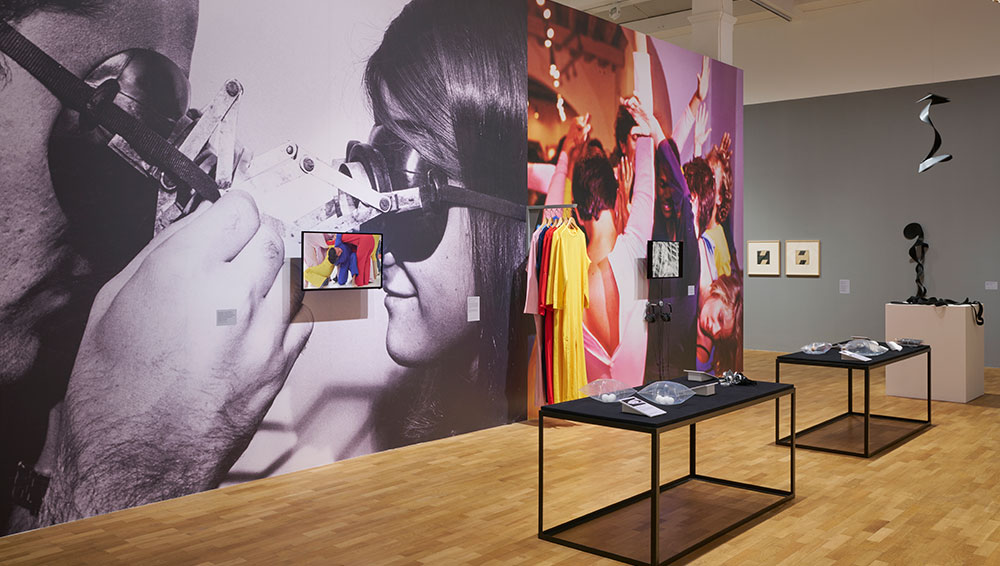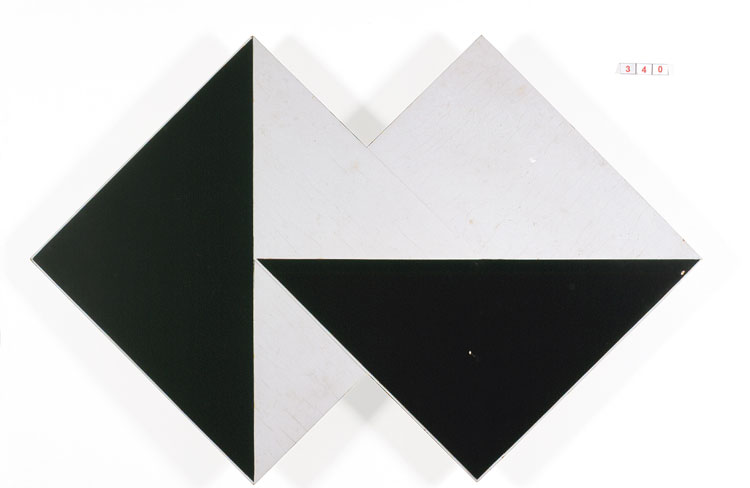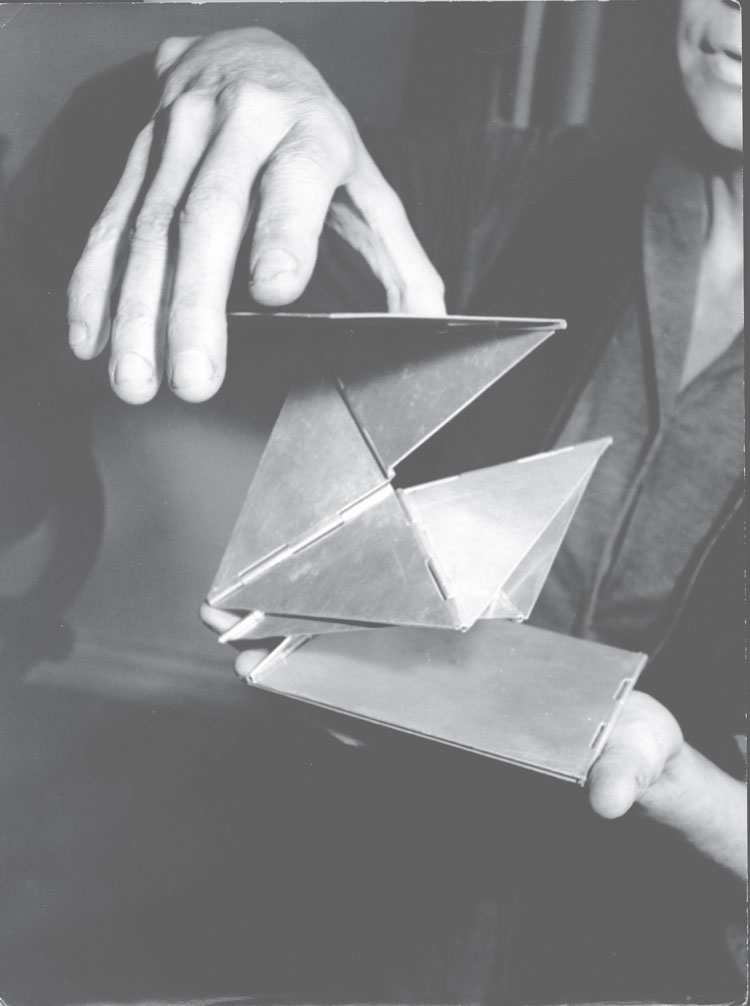
Lygia Clark: The I and the You, Whitechapel Gallery, London, 2 October 2024 – 12 January 2025. Photo: Above Ground Studio.
Whitechapel Gallery, London
2 October 2024 – 12 January 2025
by DAVID TRIGG
For four decades, the Brazilian artist Lygia Clark (1920-88) probed the boundaries between art and everyday life, through figurative and abstract paintings, interactive sculptures and “propositions”, which required the physical participation of spectators. That her work has not, until now, been the subject of a major UK exhibition is not wholly surprising: her radical practice is stubbornly resistant to tidy categories, posing a challenge to curators looking for a neat through-line. Nevertheless, this concise exhibition at London’s Whitechapel Gallery attempts to draw one, showing how her preoccupation with geometric abstraction in the 50s gave way in the 60s to a greater focus on sensory experience and on diminishing the gap between art and audience.

Lygia Clark. Bicho, 1960-84. Steel, installation dimensions variable. Courtesy: AlisonJacques, London © O Mundo de Lygia Clark-Associação Cultural, Rio de Janeiro;photo: Michael Brzezinski.
The show opens with works on paper and three-dimensional models that reveal Clark’s fascination with architecture, spatial structures and the European abstract art she encountered while studying in Paris. Her cubist leanings are seen in the early staircase sketch Escadas (Stairs, 1951), while a series of untitled constructivist-inflected drawings from 1952 show her exploring space in increasingly complex ways through various arrangements of hard-edged, geometric forms. Things become pared back in her maquettes of interior spaces from 1955, which reflect the influence of Theo van Doesburg, while a couple of playful architectural propositions made from stacked and painted matchboxes nearly a decade later, in 1964, echo suprematist architectural models.

Lygia Clark. Superficie Modulada (Modulated Surfaces), 1958/1984. Industrial ink on wood, 42 x 63 cm. Photo: Marcelo Ribeiro Alvares Corrêa. Courtesy of Associacão Cultural O Mundo de Lygia Clark.
As a proponent of concrete art, Clark continued her investigations into structure and what she called the “organic line”, the fissure of space observed between material elements such as a door and its lintel, tiles on the wall, or floorboards. This line is interrogated again and again in the minimalistic paintings and collages of her series Superfícies Moduladas (Modulated Surfaces, 1954-58) and Espaço Modulado (Modulated Space, 1958), in which various configurations of flat planes are separated by very thin gaps. Similarly, her reductive, geometric compositions titled Planos em superfícies moduladas (Planes in Modulated Surfaces, 1957-58) reveal an almost obsessive interrogation of geometric form in which the organic line isolates and connects different monochromatic elements.

Lygia Clark. Planos em superfícies moduladas (Planes in Modulated Surfaces, 1957. Collage, cardboard, 14.4 x 54 cm. Photo: Marcelo Ribeiro Alvares Corrêa. Courtesy of Associacão Cultural O Mundo de Lygia Clark.
In 1959, the Neoconcrete Manifesto was published in Rio de Janeiro, proposing a more sensual and poetic version of concretism that focused on the physical experience of art. Clark became a key figure within the movement (alongside Amilcar de Castro, Ferreira Gullar, Hélio Oiticica, Lygia Pape and others), pushing at the limits of conventional artistic forms with works such as her Bichos (Critters). These metal sculptures (the first of her participatory works from the early 1960s) comprise several flat geometric components hinged together. Encouraging viewers to get hands-on, they can be moved and manipulated into numerous surprising shapes. Despite their industrial aesthetic, Clark likened them to living creatures. “When I’m asked how many movements the Bicho can make,” she once wrote, “I answer: ‘I don’t know, you don’t know, but it knows.’”

Lygia Clark. Bicho de Bolso, 1967. Photo: Michel Desjardins. Courtesy of Associacão Cultural O Mundo de Lygia Clark.
Clark’s original Bichos are now too fragile to be handled and are displayed in glass vitrines. However, an abundance of replicas are available to be played with here. Like movable versions of her paintings, these ever-changing sculptural forms are inherently unstable (as attested by the incessant clattering that filled the gallery during my visit) but addictively fun. They are presented as the bridge between Clark’s pared-down geometric works and the radical participatory projects that she pursued in the years that followed.
A pivotal work in Clark’s oeuvre is Caminhando (Walking, 1963), in which viewers sit at a small table and create a paper Möbius strip. While the resultant twisted loop evokes thoughts of infinity, the piece more importantly proposes art as an active and experiential exercise rather than a passive experience. This was, in the words of the British critic Guy Brett, a “radical leap” as Clark moved away from conventional artworks towards the tactile experiments that came to characterise her later career.
Taking inspiration from the ideas of the influential British psychoanalyst Donald Winnicott about play and object relations theory, Clark’s participatory works, which she dubbed “Relational Objects”, involve simple structures made from everyday objects (stones, shells, rubber bands and the like). You are invited to touch and play with several of these, including Livro Sensorial (Sensorial Book, 1966), a book whose plastic pages are filled with different sensory materials; Respire Comigo (Breathe with Me, 1966), which comprises a piece of rubber tubing intended to “encourage a meditative experience” when squeezed like an accordion, and Ping Pong (1966), a sealed polythene bag containing air and plastic balls that you are instructed to hold between your hands to “explore the sound they make and notice the relationship between weight and lightness”.
It is difficult to appreciate just how radical these were in 1966 and, indeed, the cultural impact they had in Clark’s home country. The Brazilian songwriter and musician Caetano Veloso even paid homage to the artist in his 1971 song If You Hold a Stone. Its lyrics refer to her first Relational Object, Stone and Air (1966), an air-filled bag on which rests a pebble; by slowly squeezing the bag in time with your breathing, the stone rises and falls as an evocation of the body’s life-sustaining processes. Clark may have been a pioneer in this kind of practice but with play-led learning long-established in educational settings, such works now appear tired and passé.
-1967.jpg)
Lygia Clark. Proposiçāo 'O eu e o tu' (Proposition 'The I and the You'), 1967. Photo: Vicente de Mello Sem data. Courtesy Associacão Cultural O Mundo de Lygia Clark.
In 1967, Clark devised Proposiçāo “O eu e o tu” (Proposition “The I and the You”) from which the exhibition takes its title. This intimate performance involves two participants donning plastic spacesuit style outfits connected by a length of tubing. With their eyes covered by helmets, they explore each other’s suited bodies, unzipping pockets to discover materials including foam, straw and fluff. While this kind of activity retains a modicum of transgressive radicalism, whatever psychoanalytical theory Clark originally had in mind became lost amid the giggles of the plucky participants on the day of my visit.
Clark’s interest in exploring group dynamics and provoking intimate relations between people developed into a form of art therapy, which she pursued vigorously after moving to Paris in 1968. Working with students at the Sorbonne University, she devised numerous therapeutic exercises, including Rede de Élasticos (Elastic Net, 1973), a large web of elastic bands intended to be explored in groups; an accompanying archival video shows participants writhing around under the net as if caught in a trap.
-1973.jpg)
Lygia Clark. Rede de Elásticos (Elastic Net), 1973. Rede de Elásticos, Paris, sem data. Photo: Hagêge A. Courtesy of Associacão Cultural O Mundo de Lygia Clark.
Whether or not Clark considered this and similar projects to be seen as art is a moot point; her activities in and out of the gallery have had a transformative impact on generations of artists, including Sonia Boyce, who co-curated this exhibition (alongside the Anglo-Brazilian art scholar Michael Asbury and Whitechapel Gallery director Gilane Tawadros) and whose own show, An Awkward Relation, is running concurrently in the upper galleries. Clark believed that art could change the world and while her work may have lost its revolutionary edge, its legacy remains a touchstone for those interested in questioning the limits of conventional art forms.